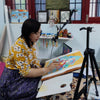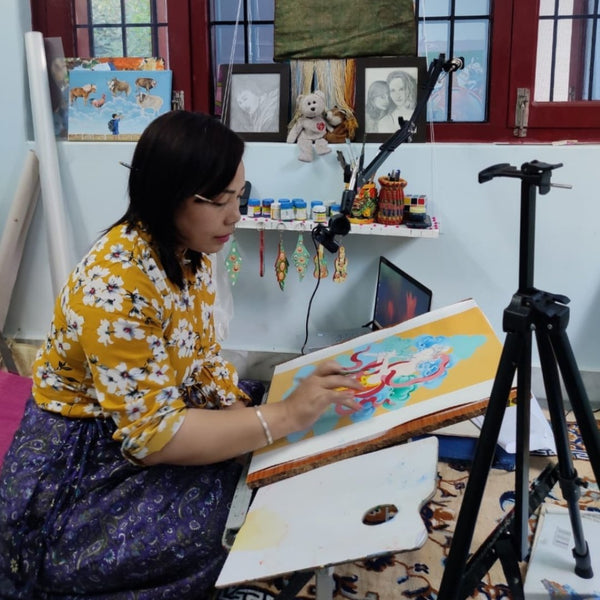Thangka
Art
Thangka art (hangka, tangka, thanka) is a traditional form of Tibetan Buddhist painting executed on cotton or silk canvas. However, it is widely practiced in India, especially in the Himalayan regions where Tibetan Buddhism is prevalent. Traditionally, Thangka paintings are sacred scrolls that were instrumental in teaching and meditation, depicting Buddhist themes and events including mandalas (symbolic representations of the universe), deities, and scenes from scriptures that resonated with devotional or religious sentiments. While the painting style and themes predominantly follow the same Tibetan tradition, some Thangkas may reflect the syncretic nature of local Buddhist practices, portraying regional deities and events, noticeable in the Sikkimese Thangka or others.
History of Thangka Painting
Thangka art, or "scroll painting," has its origin in early Buddhist paintings like Ajanta Caves in India or Mogao Caves in China. It was initially developed in Tibet as a portable form of religious art, however when it reached back to India, the regions of Himachal Pradesh, Ladakh, Sikkim, and Arunachal Pradesh became centers for preserving and practicing this distinct art form.
As per some legends, King Uttrayan Bimbisara of Magodha commissioned a painting of Sakyamuni Buddha. However, the assigned artist could not draw him because of his blinding holiness. So, in the end, the artist observed Buddha’s reflection in nearby water and completed the painting. This precisely marked the origin of Thangka when the artist captured Buddha’s spiritual reflection making it a spiritual force of divinity.
Thangka art is rich in symbolism and often depicts scenes from Buddhist scriptures and legends. One common theme is the depiction of the Wheel of Life, which illustrates the Buddhist concept of samsara, or the cycle of rebirth. Similarly, the Mandala is another such motif, representing the cosmos, often used for meditation and spiritual guidance.
Thangka Painting Technique
Creating a Thangka painting is a meticulous and time-consuming process. Artists use a mix of traditional materials, including cotton or silk for the canvas and natural pigments for the colors. At first, a well-treated, smooth canvas is stretched on a bamboo frame. The artist outlines the image with charcoal or pencil under strict religious guidelines as every stance, gesture, mood, and color has a deep meaning in Thangka painting.
Natural pigments derived from minerals and plants are used to fill vibrant colors in the drawing. The use of color is of great significance in Thangka painting, as it assists in identifying the different deities. The key elements in the composition are often highlighted with gold leaf. Traditionally, the painted Thangkas are framed with rich silk brocades and finally covered with a protective curtain made of finer silk.
It can take months to complete a single detailed work of Thangka as it not only requires the skill of painting but the artist has to be well equipped with the knowledge of Buddhist scriptures and iconography. In earlier times, monks or lamas would only work on Thangka paintings after spending years devoted to Buddhist studies. Krishna Tashi Palmo and Gyaltsen Zimba are some of the exceptional artists practicing this exquisite art form.
FAQs
Are all Thangka paintings original and hand-painted?
Yes, at MeMeraki, all Thangka paintings are 100% original and hand-painted by skilled artists. Each piece is crafted using traditional techniques, ensuring the authenticity and cultural significance of the artwork.
Can Thangka art be personalized?
Thangka art follows strict iconographic guidelines, so personalization is typically limited to specific requests within those boundaries. MeMeraki may accept commissions for particular deities or scenes, but the overall style and symbolism will remain true to traditional Thangka practices.
How do Thangka paintings differ from other religious artworks?
Thangka paintings are unique due to their deep connection with Tibetan Buddhism, their specific use in meditation and rituals, and the strict adherence to traditional iconography. The intricate details, use of natural pigments, and the inclusion of spiritual symbolism set Thangkas apart from other religious artworks.
What is the significance of the gold used in Thangka paintings?
Gold in Thangka paintings symbolizes the divine and is used to highlight specific features such as halos, jewelry, or sacred symbols. The use of gold not only enhances the aesthetic value of the painting but also elevates its spiritual significance.
Can Thangka art be used in non-religious settings?
While Thangka art is deeply rooted in Buddhist religious practices, it is also appreciated for its artistic and cultural value. Thangkas can be displayed in non-religious settings, but it is important to do so with respect for their spiritual origins.
What is the cultural significance of Thangka art in Tibetan Buddhism?
Thangka art holds immense cultural significance in Tibetan Buddhism as it serves as a bridge between the spiritual and the material world. It is not only a visual representation of Buddhist teachings but also a sacred object that aids in meditation and religious rituals.
![]() Get Upto 10% OFF on purchase of this product.
Get Upto 10% OFF on purchase of this product.
![]() Get upto 10% OFF on Live Workshops when sign up for 2 or more workshops.
Get upto 10% OFF on Live Workshops when sign up for 2 or more workshops.
![]() Get 10% OFF coupon code for Art Kits signing up for Masterclass or Live Workshop.
Get 10% OFF coupon code for Art Kits signing up for Masterclass or Live Workshop.
![]() Earn upto 1,500 Points on purchase of this product.
Earn upto 1,500 Points on purchase of this product.





